A plane can be completely illustrated by denoting two intersecting lines which can be translated into a fixed point A and two nonparallel direction vectors. The position vector $\overrightarrow{r}$ of any general point P on the plane passing through point A and having direction vectors $\overrightarrow{b}$ and $\overrightarrow{c}$ is given by the equation
Vector equation of a plane
$\overrightarrow{r}=\overrightarrow{a}+\lambda \overrightarrow{b}+µ\overrightarrow{c} \lambda, µ∈R (\overrightarrow{AP}=\lambda \overrightarrow{b}+µ\overrightarrow{c})$
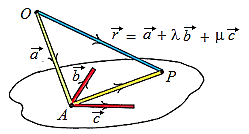
Parametric equation of a plane: λ , μ are called a parameters λ,μ ∈ R
$ (\begin{matrix}
x & \\
y & \\
z & \\
\end{matrix}
)=(\begin{matrix}
a_{1} & \\
a_{2} & \\
a_{3} & \\
\end{matrix}
)+\lambda (\begin{matrix}
b_{1} & \\
b_{2} & \\
b_{3} & \\
\end{matrix}
)+\mu (\begin{matrix}
c_{1} & \\
c_{2} & \\
c_{3} & \\
\end{matrix}
) => \begin{matrix}
x=a_{1}+\lambda b_{1}+\mu c_{1} & \\
y=a_{2}+\lambda b_{2}+\mu c_{2} & \\
z=a_{3}+\lambda b_{3}+\mu c_{3} & \\
\end{matrix}
$
If N is considered to be normal to a given plane, then all other normals to that plane are considered parallel to N which are resultantly scalar multiples of N., In particular,we can say that there are two normals of length 1:

Normal/Scalar product form of vector equation of a plane

Consider a vector n passing through a point A. Only one plane through A can be is perpendicular to the vector. Now consider R being any point on the plane other than A as shown above. Then we can say that
$\overrightarrow{n}.\overrightarrow{AR}=0$
$\overrightarrow{n}.\overrightarrow{(r}-\overrightarrow{a})=0$
$\overrightarrow{n}.\overrightarrow{r}= \overrightarrow{n}.(\overrightarrow{a}+\lambda \overrightarrow{b}+µ\overrightarrow{c})$\textit{⇒}$
\overrightarrow{r}.\overrightarrow{n}=\overrightarrow{a}.\overrightarrow{n} or \overrightarrow{n}.(\overrightarrow{r}-\overrightarrow{a})= 0
$
Cartesian equation of a plane
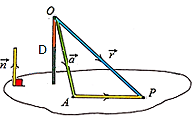
$\overrightarrow{r}.\overrightarrow{n}=\overrightarrow{a}.\overrightarrow{n} ⤇ n_{1}x+n_{2}y+n_{3}z=n_{1}a_{1}+n_{2}a_{2}+n_{3}a_{3 }=d$
$n_{1}x+n_{2}y+n_{3}z=d$
$D= \vert \overrightarrow{r}.{n}\vert =\vert \overrightarrow{a}.{n}\vert $
{=}$\frac{\vert \overrightarrow{a}.\overrightarrow{n}\vert }{\sqrt{n_{1}^{2}+n_{2}^{2}+n_{3}^{2}}}=\frac{\vert n_{1}a_{1}+n_{2}a_{2}+n_{3}a_{3 }\vert }{\sqrt{n_{1}^{2}+n_{2}^{2}+n_{3}^{2}}}$
Therefore, the Cartesian form is
![]()
where n1, n2 and n3 are the components of n and where n is called the normal vector.
Example: Find the equation of the plane passing through the three points P1(1,-1,4), P2(2,7,-1), and P3(5,0,-1).
$\overrightarrow{b}=\overrightarrow{P_{1}P_{2}}= (\begin{matrix}
1 & \\
8 & \\
-5 & \\
\end{matrix})$
$\overrightarrow{c}= \overrightarrow{P_{1}P_{3}} = (\begin{matrix}
4 & \\
1 & \\
-5 & \\
\end{matrix}
)$
$P_{1}=(\begin{matrix}
1 & \\
-1 & \\
4 & \\
\end{matrix}
)$
In vector form:
$ \overrightarrow{r}=(\begin{matrix}
1 & \\
-1 & \\
4 & \\
\end{matrix}
) +\lambda (\begin{matrix}
1 & \\
8 & \\
-5 & \\
\end{matrix}
)+µ(\begin{matrix}
4 & \\
1 & \\
-5 & \\
\end{matrix}
)$
$\overrightarrow{n}=\vert \begin{matrix}
{i} & {j} & {k} & \\
1 & 8 & -5 & \\
4 & 1 & -5 & \\
\end{matrix}
\vert =(\begin{matrix}
-35 & \\
-15 & \\
-31 & \\
\end{matrix}
)$
Any non-zero scalar multiples of $\overrightarrow{n}$ is also a normal vector of the plane. Therefore, Multiply by -1.
$\overrightarrow{n}=(\begin{matrix}
35 & \\
15 & \\
31 & \\
\end{matrix}
)$
$(\begin{matrix}
35 & \\
15 & \\
31 & \\
\end{matrix}
).(\begin{matrix}
1 & \\
-1 & \\
4 & \\
\end{matrix}
)=144$
$Cartesian form:$
$35x+15y+31z=144$
Example: Find the equation of the plane with normal vector $
(\begin{matrix}
1 & \\
3 & \\
5 & \\
\end{matrix}
)$containing the point (-2, 3, 4).
$(\begin{matrix}
1 & \\
3 & \\
5 & \\
\end{matrix}
).(-2,3,4)=-2+9+20=27$
x+3y+5z=27
Example: Find the distance of the plane $
\overrightarrow{r}.(\begin{matrix}
3 & \\
2 & \\
-4 & \\
\end{matrix}
)$ = 8 from the origin, and the unit vector perpendicular to the plane.
$\vert (\begin{matrix}
3 & \\
2 & \\
-4 & \\
\end{matrix}
) \vert =\sqrt{29}$
$\frac{1}{\sqrt{29}}\lbrack \overrightarrow{r}.(\begin{matrix}
3 & \\
2 & \\
-4 & \\
\end{matrix}
)\rbrack = \frac{8}{\sqrt{29}}$
$D= \frac{8}{\sqrt{29}} {n}= \frac{1}{\sqrt{29}}(\begin{matrix}
3 & \\
2 & \\
-4 & \\
\end{matrix}
)$
Example: Find the Cartesian equation of the plane through the point A (1, 1, 1) perpendicular to the vector
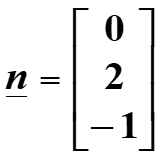
Solution:

Example: Show that the following vector is perpendicular to the plane containing the points A(1, 0, 2), B(2, 3, -1) and C(2, 2, -1 ).
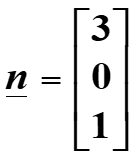
Solution:
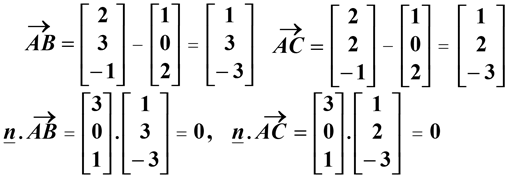
In conclusion, n is a vector that is perpendicular to 2 vectors in the plane so it is perpendicular to the plane.
